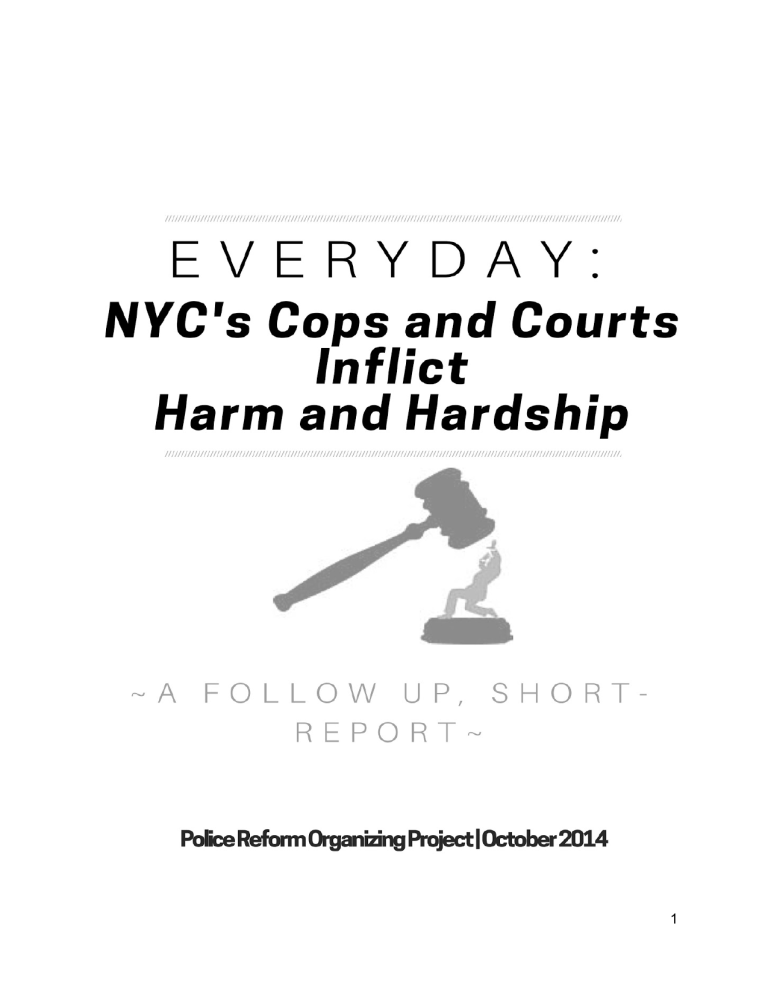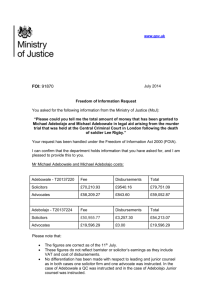Everyday : NYC's Cops and Courts Inflict Harm and Hardship

1
Police Reform Organizing Project (PROP)
Mission Statement
The Police Reform Organizing Project is a city-wide coalition that seeks through research and analysis, policy advocacy, public education, and community organizing to establish a Police Department that serves and protects all New Yorkers, especially the vulnerable people among us, and that works to achieve a more safe, fair, and inclusive city for all its citizens.
2
Everyday : NYC’s Cops and Courts Inflict Harm and Hardship
Introduction
“We who engage in nonviolent direct action are not the creators of tension. We merely bring to the surface the hidden tension that is already alive. Like a boil that can never be cured so long as it is covered up but must be opened with all its pus-flowing ugliness to the natural medicines of air and light, injustice must likewise be exposed, with all of the tension its exposing creates, to the light of human conscience and the air of national opinion before it can be cured.”
– Martin Luther King Jr.
Everyday the NYPD’s “broken windows” arrest practices inflict hardship and harm on the most vulnerable New Yorkers, especially low income people of color, the homeless, and the mentally ill. That is the most compelling lesson that PROP has learned through its Court Monitoring Project.
Everyday New
York’s district attorneys aggressively prosecute cases against black and brown people for engaging in mainly innocent or innocuous activities.
Everyday our city’s courts devote considerable resources to the administration of injustice, applying sanctions in 100’s, if not 1,000’s, of cases where the charges involve, at worst, petty infractions and where the defendants are almost always people of color, some of whom live/survive on the margins of society.
We at PROP believe that the more the public, press, and politicians know about these everyday injustices, the more likely that the political landscape regarding policing and the courts will shift, and the more likely that the city’s policy makers will enact the sweeping reforms needed to address and correct this serious and shameful problem.
It is in this spirit that we have prepared this PROP short-report as a follow up to our summer publication, Broken Windows Policing: A True Tale of Two leaders sidestep this issue, our so-called criminal justice system inflicts harm call this paper, Everyday, as a reminder that everyday that NYC’s political and hardship on low-income people of color. It is a painful irony that the people targeted by “broken windows” policing make up the very constituency
representing the political base of the city’s leaders proud to call themselves progressives, including Mayor Bill de Blasio, City Council Speaker Melissa
Mark-Viverito, Public Advocate Letitia James, and City Councilpersons Brad
Lander and Jumaane Williams.
Everyday strives to serve as a compelling reminder that it is time for this particular group of city leaders to take significant steps to fix our broken and unjust criminal justice system and to create a fair, safe, equitable, and inclusive city for all New Yorkers.
3
Report Summary:
● Of the 191 cases seen, 173 or 91% of the defendants were people of color.
● Of the 191 cases seen, 163 or 85% of defendants walked out of the courtroom.
● Of the 3 court visits that PROP was able to time, the average time that the court spent on each case was approximately 2 minutes, 34 seconds. The longest case lasted 10 minutes, 37 seconds. The shortest case lasted 7 seconds.
Court Reports:
Arraignment Part, Room 129
Manhattan Criminal Court
September 12th, 2014
● Of the 24 cases seen, 19 of 22 (2 defendants were not present in court, but their cases were called) or 86% of defendants were people of color.
● Common Charges:
○ Consumption of alcohol in a public place
○ Petit larceny
○ Assault in the 3rd degree
● 18 of the 22 or 82% of the defendants walked out of the courtroom.
* Manhattan’s Demographics:
48% White
12.9% Black
0.1% American Indian and Alaska Native
11.3% Asian
0.1% Native Hawaiian and Other Pacific Islander
25.4% Hispanic
Arraignment Part, AR2 Room 105 September 19th, 2014
Brooklyn Criminal Court
● Of the 47 cases seen, 46 or 98% of the defendants were people of color.
● Common charges:
4
○ Criminal possession of a controlled substance in the 7th degree (possessing drug residue)
○ Driving with a suspended license
○ Criminal possession of marijuana in the 3rd degree
○ Open alcohol container
● 42 of 47 or 89% of the defendants walked out of the courtroom.
* Brooklyn’s demographics:
35.5% White
31.9% Black
0.2% American Indian and Alaska Native
10.4% Asian
0.0% Native Hawaiian and Other Pacific Islander
19.8% Hispanic
Arraignment Part, AR2 Room 105
Brooklyn Criminal Court
September 23rd, 2014
● Of the 34 cases seen, 33 or 97% of the defendants were people of color.
● Common charges:
○ Theft of services (usually a subway infraction)
○ Driving with a suspended license
○ Open alcohol container
● 31 of 34 or 91% of the defendants walked out of the courtroom.
* Brooklyn’s demographics: (adds up to 99.8%)
35.5% White
31.9% Black
0.2% American Indian and Alaska Native
10.4% Asian
0.0% Native Hawaiian and Other Pacific Islander
19.8% Hispanic
5
Arraignment Part, Room 129
Manhattan Criminal Court
September 25th, 2014
● Of the 73 cases seen, 62 or 85% of the defendants were people of color.
● Common charges:
○ Criminal possession of a controlled substance in the 7th degree (possessing drug residue)
○ Criminal possession of marijuana in the 5th degree
○ Criminal trespass in the 3rd degree & trespass (a trespass violation charge is always added)
○ Petit larceny & criminal possession of stolen property in the 5th degree
○ Theft of services (usually a subway infraction)
○ Trademark counterfitting (selling knockoff designer products)
○ Unlawful solicitation (in a NYC park or subway)
● 69 of 73 or 95% of the defendants walked out of the courtroom.
* Manhattan’s Demographics:
48% White
12.9% Black
0.1% American Indian and Alaska Native
11.3% Asian
0.1% Native Hawaiian and Other Pacific Islander
25.4% Hispanic
September 26th, 2014
Arraignment Part (Felony & Misdemeanor)
Queens Criminal Court
● Of the 11 cases seen, 13 out of 13 (two cases had codefendants) or 100% of the defendants were people of color.
● Common charges:
○ Assault in the 2nd degree
○ Criminal contempt (violating an order of protection)
● 3 of 13 or 23% of the defendants walked out of the courtroom.
* Queens:
27.6% White
17.7% Black
0.3% American Indian and Alaska Native
22.8% Asian
6
0.0% Native Hawaiian and Other Pacific Islander
27.5% Hispanic
*Demographic percentages taken from the 2010 Census of the US Census Bureau
**All races excluding “Hispanic” are taken from nonHispanic category
7
Things People Are Arrested For
NYC police officers arrest people, usually low income individuals of color, cuff and confine them, for these activities:
• Walking between subway cars, sometimes even when the train is stopped
• Riding a bicycle on the sidewalk
• Holding an open alcohol container, though the detained person often claims that it was soda or water
• Occupying two seats on a subway even when the train is mostly empty or is not crowded
• Putting a foot on a subway seat
• Putting a backpack on a subway seat
• Using a loved one's metro card to enter the subway
• Asking another person to swipe you onto the subway
• Possessing fireworks
• Asking people for a handout while holding open a door to an ATM
• Sleeping on the subway
• Sleeping on a park bench
• Begging on the subway or in other public places
• Standing in front or in the lobby of your own building
• Driving with a suspended license even if the driver is not aware that the license is suspended
• Insisting on your rights when stopped and questioned for no apparent reason
• Filming/recording, while not interfering with, a police activity such as ticketing or arresting a street vendor or roughing up a detained person
• Being a street vendor and not locating your cart the prescribed distance from the curb or not properly displaying your license or displaying artificial flowers when your license is for selling only real flowers
• Being a pedicab driver and parking in an unauthorized space or not properly displaying your rates
• Being homeless and hungry and taking a small amount of food or drink from a store
• Jaywalking
• Selling loose or untaxed cigarettes
8
Stories
Police officers approached two Latino men setting on a stoop at night on the Lower East
Side. The officers focused on one of the men who was using an app on his iPhone. They asked him why he had pissed on the sidewalk and when he denied doing so, slapped the phone out of his hand, grabbed him and forced him to stand up. The man’s uncle is a police captain and he quickly brought out from his jacket pocket a card indicating his uncle’s status. The officers abruptly changed their tone and manner and left the scene.
Several young officers, possibly rookies, approached a middle-aged African-American woman who was walking along a street in Washington Heights. The officers yelled that she was talking too loudly on her cell phone. Taken by surprise, she stopped - she was one building away from her own apartment house - and challenged the officers, saying that she was doing nothing wrong. Speaking more rudely to her in front of witnesses, the officers grabbed and shoved her, causing black and blue bruises to her arms. They cuffed her, forced her into a police car, and drove her to the local precinct where she was held several hours before being released. Back at her apartment, she found several summonses in her pocketbook, one for disorderly conduct and one for spitting. Her money, though, was missing and the local precinct has stonewalled her efforts to retrieve it. Several days before her court date, a notice arrived in the mail dismissing all the charges against her.
Police officers arrested an African-American woman in Brooklyn because her two small children had attempted to walk out of a grocery store with fish hidden under their clothes. The judge released the woman, who claimed not to know what her youngsters were doing, on her own recognizance. She left the courtroom clearly worried about losing custody of her children.
Police officers arrested a man who was driving a car that had a broken taillight. They had pulled him over on that infraction, run a check on him and found that he had an outstanding warrant on an open alcohol container charge.
Last September several officers stopped a young man who had just jumped a turnstile as he tried to enter a subway that had just pulled into the station. The man wore clothes and tattoos indicating his punk rock associations and the officers made rude comments about punk rockers as they forced him to the ground. He tried to explain that he had just bought a $20, metrocard and jumped the turnstile because it kept asking him to swipe again and he didn’t want to miss his train. He offered to show them the new card and swipe it through, but the officers would not let him up and pressed his face on the
9
platform. They then cuffed and arrested him – he spent 36 hours locked up before seeing the arraignment judge who ordered him released.
10
Conclusion
The recent display online of videos showing the brutal and cavalier actions and attitudes of NYPD officers has shocked many New Yorkers. It has returned the problem of abusive policing to the mainstream policy-making and media arena and has led to increased pressure on de Blasio / Bratton to re-orient the city's approach to law enforcement away from"broken windows" policing to a more collaborative model.
The findings of PROP's ongoing court monitoring project document the harmful and biased impact of the aggressive and needless application of the
NYPD's "broken windows" approach. In most of the cases that PROP observed, the accused walked out of the courtroom with the charge dismissed or a minor sanction applied. The court had clearly decided that the person was not a risk to the community. In many cases, we saw the defendant shaking his head or
mumbling under his breath in apparent anger or frustration.
This kind of policing – effectively criminalizing activities that are victimless, and seen by most people as harmless, and disproportionately charging one group of persons as offenders – breeds cynicism, resentment, and resistance and can lead, in worst case scenarios, to senseless injury and death.
11





